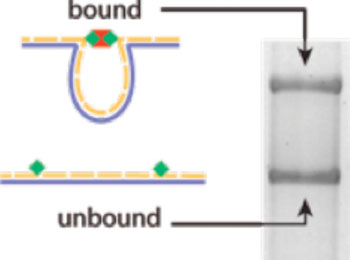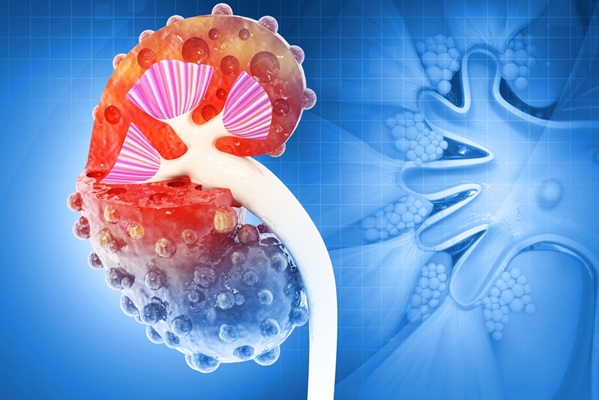Low Cost Platform for Studying Molecular Interactions Based on DNA Gel Electrophoresis
|
By LabMedica International staff writers Posted on 18 Feb 2015 |

Image: Programmable, self-assembled DNA nanoswitches serve both as templates for positioning molecules, and as sensitive, quantitative reporters of molecular association and dissociation. The figure depicts gel electrophoresis separation of linear and closed loop DNA strands (Photo courtesy of Harvard Medical School).
A novel platform for studying molecular interactions is based on the separation of linear and circular forms of DNA by gel electrophoresis.
Investigators at Harvard Medical School (Boston, MA, USA) devised a system that used "nanoswitches," strands of DNA onto which molecules of interest were strategically attached at various locations along the strand. Interactions between these molecules, such as binding of a drug compound to its intended target or binding of a protein to its receptor on a cell, caused the shape of the DNA strand to change from an open and linear shape to a closed loop. DNA that had morphed into a closed loop form was easily separated from linear DNA by gel electrophoresis.
The investigators demonstrated this low-cost, versatile, "lab-on-a-molecule" system by characterizing ten different interactions, including a complex four-body interaction with five discernible states. This study was published in the February 2015 issue of the journal Nature Methods.
"Bio–molecular interaction analysis, a cornerstone of biomedical research, is traditionally accomplished using equipment that can cost hundreds of thousands of dollars," said senior author Dr. Wesley P. Wong, assistant professor of biological chemistry and molecular pharmacology at Harvard Medical School. "Rather than develop a new instrument, we have created a nanoscale tool made from strands of DNA that can detect and report how molecules behave, enabling biological measurements to be made by almost anyone, using only common and inexpensive laboratory reagents."
Related Links:
Harvard Medical School
Investigators at Harvard Medical School (Boston, MA, USA) devised a system that used "nanoswitches," strands of DNA onto which molecules of interest were strategically attached at various locations along the strand. Interactions between these molecules, such as binding of a drug compound to its intended target or binding of a protein to its receptor on a cell, caused the shape of the DNA strand to change from an open and linear shape to a closed loop. DNA that had morphed into a closed loop form was easily separated from linear DNA by gel electrophoresis.
The investigators demonstrated this low-cost, versatile, "lab-on-a-molecule" system by characterizing ten different interactions, including a complex four-body interaction with five discernible states. This study was published in the February 2015 issue of the journal Nature Methods.
"Bio–molecular interaction analysis, a cornerstone of biomedical research, is traditionally accomplished using equipment that can cost hundreds of thousands of dollars," said senior author Dr. Wesley P. Wong, assistant professor of biological chemistry and molecular pharmacology at Harvard Medical School. "Rather than develop a new instrument, we have created a nanoscale tool made from strands of DNA that can detect and report how molecules behave, enabling biological measurements to be made by almost anyone, using only common and inexpensive laboratory reagents."
Related Links:
Harvard Medical School
Latest BioResearch News
- Genome Analysis Predicts Likelihood of Neurodisability in Oxygen-Deprived Newborns
- Gene Panel Predicts Disease Progession for Patients with B-cell Lymphoma
- New Method Simplifies Preparation of Tumor Genomic DNA Libraries
- New Tool Developed for Diagnosis of Chronic HBV Infection
- Panel of Genetic Loci Accurately Predicts Risk of Developing Gout
- Disrupted TGFB Signaling Linked to Increased Cancer-Related Bacteria
- Gene Fusion Protein Proposed as Prostate Cancer Biomarker
- NIV Test to Diagnose and Monitor Vascular Complications in Diabetes
- Semen Exosome MicroRNA Proves Biomarker for Prostate Cancer
- Genetic Loci Link Plasma Lipid Levels to CVD Risk
- Newly Identified Gene Network Aids in Early Diagnosis of Autism Spectrum Disorder
- Link Confirmed between Living in Poverty and Developing Diseases
- Genomic Study Identifies Kidney Disease Loci in Type I Diabetes Patients
- Liquid Biopsy More Effective for Analyzing Tumor Drug Resistance Mutations
- New Liquid Biopsy Assay Reveals Host-Pathogen Interactions
- Method Developed for Enriching Trophoblast Population in Samples
Channels
Clinical Chemistry
view channel
Gold Nanoparticles to Improve Accuracy of Ovarian Cancer Diagnosis
Ovarian cancer is considered one of the deadliest cancers, in part because it rarely shows clear symptoms in its early stages, and diagnosis is often complex. Current approaches make it difficult to accurately... Read more
Simultaneous Cell Isolation Technology Improves Cancer Diagnostic Accuracy
Accurate cancer diagnosis remains a challenge, as liquid biopsy techniques often fail to capture the complexity of tumor biology. Traditional systems for isolating circulating tumor cells (CTCs) vary in... Read moreMolecular Diagnostics
view channel
Routine Blood Draws Could Detect Epigenetic Biomarkers for Predicting Cardiovascular Disease Risk
Cardiovascular disease is a leading cause of death worldwide, yet predicting individual risk remains a persistent challenge. Traditional risk factors, while useful, do not fully capture biological changes... Read more
Single Cell RNA Sequencing Could Enable Non-Invasive Blood Disorder Diagnosis
Hematologic disorders are often diagnosed using painful, invasive, and expensive bone marrow aspiration or biopsy procedures. These approaches limit patient compliance and broader utility, leaving a need... Read more
Blood Test Identifies HPV-Associated Head and Neck Cancers 10 Years Before Symptoms
Human papillomavirus (HPV) causes around 70% of head and neck cancers in the United States, and cases are rising each year. Unlike cervical cancers linked to HPV, there is currently no screening test for... Read moreHematology
view channel
Pioneering Model Measures Radiation Exposure in Blood for Precise Cancer Treatments
Scientists have long focused on protecting organs near tumors during radiotherapy, but blood — a vital, circulating tissue — has largely been excluded from dose calculations. Each blood cell passing through... Read more
Platelets Could Improve Early and Minimally Invasive Detection of Cancer
Platelets are widely recognized for their role in blood clotting and scab formation, but they also play a crucial role in immune defense by detecting pathogens and recruiting immune cells.... Read more
Portable and Disposable Device Obtains Platelet-Rich Plasma Without Complex Equipment
Platelet-rich plasma (PRP) plays a crucial role in regenerative medicine due to its ability to accelerate healing and repair tissue. However, obtaining PRP traditionally requires expensive centrifugation... Read moreImmunology
view channel
Companion Diagnostic Test Identifies HER2-Ultralow Breast Cancer and Biliary Tract Cancer Patients
Breast cancer is the most common cancer in Europe, with more than 564,000 new cases and 145,000 deaths annually. Metastatic breast cancer is rising in younger populations and remains the leading cause... Read more
Novel Multiplex Assay Supports Diagnosis of Autoimmune Vasculitis
Autoimmune vasculitis and related conditions are difficult to diagnose quickly and accurately, often requiring multiple tests to confirm the presence of specific autoantibodies. Traditional methods can... Read more
Blood Test Predicts Immunotherapy Efficacy in Triple-Negative Breast Cancer
Triple-negative breast cancer (TNBC) is an aggressive subtype lacking targeted therapies, making immunotherapy a promising yet unpredictable option. Current biomarkers such as PD-L1 expression or tumor... Read more
Simple Genetic Testing Could Predict Treatment Success in Multiple Sclerosis Patients
Multiple sclerosis (MS) patients starting therapy often face a choice between interferon beta and glatiramer acetate, two equally established and well-tolerated first-line treatments. Until now, the decision... Read moreMicrobiology
view channel
Microfluidic Platform Assesses Neutrophil Function in Sepsis Patients
Sepsis arises from infection and immune dysregulation, with neutrophils playing a central role in its progression. However, current clinical tools are unable to both isolate these cells and assess their... Read moreNew Diagnostic Method Confirms Sepsis Infections Earlier
Sepsis remains one of the most dangerous medical emergencies, often progressing rapidly and becoming fatal without timely intervention. Each hour of delayed treatment in septic shock reduces patient survival... Read more
New Markers Could Predict Risk of Severe Chlamydia Infection
Chlamydia trachomatis is a common sexually transmitted infection that can cause pelvic inflammatory disease, infertility, and other reproductive complications when it spreads to the upper genital tract.... Read more
Portable Spectroscopy Rapidly and Noninvasively Detects Bacterial Species in Vaginal Fluid
Vaginal health depends on maintaining a balanced microbiome, particularly certain Lactobacillus species. Disruption of this balance, known as dysbiosis, can increase risks of infection, pregnancy complications,... Read morePathology
view channelAccurate Pathological Analysis Improves Treatment Outcomes for Adult Fibrosarcoma
Adult fibrosarcoma is a rare and highly aggressive malignancy that develops in connective tissue and often affects the limbs, trunk, or head and neck region. Diagnosis is complex because tumors can mimic... Read more
Clinicopathologic Study Supports Exclusion of Cervical Serous Carcinoma from WHO Classification
High-grade serous carcinoma is a rare diagnosis in cervical biopsies and can be difficult to distinguish from other tumor types. Cervical serous carcinoma is no longer recognized as a primary cervical... Read moreTechnology
view channel
Coral-Inspired Capsule Samples Hidden Bacteria from Small Intestine
The gut microbiome has been linked to conditions ranging from immune disorders to mental health, yet conventional stool tests often fail to capture bacterial populations in the small intestine.... Read more
Rapid Diagnostic Technology Utilizes Breath Samples to Detect Lower Respiratory Tract Infections
Respiratory tract infections (LRTIs) are leading causes of illness and death worldwide, particularly among vulnerable populations such as the elderly, young children, and those with compromised immune systems.... Read moreIndustry
view channel
Werfen and VolitionRx Partner to Advance Diagnostic Testing for Antiphospholipid Syndrome
Antiphospholipid syndrome (APS) is a rare autoimmune disorder that causes the immune system to produce abnormal antibodies, making the blood “stickier” than normal. This condition increases the risk of... Read more




















